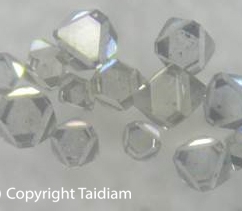Articles and News
New Lab-Grown Octahedral Diamonds Very Hard To Detect | July 15, 2015 (0 comments)

Antwerp, Belgium—One of the key weapons in the industry’s arsenal against undisclosed synthetic diamonds may just have been blunted.
Previously telling natural rough diamonds from lab-grown rough diamonds was fairly straightforward due to the typical cubo-octahedral shape of diamonds produced by HPHT (high pressure high temperature) or the characteristic plate structure of diamonds produced by CVD (chemical vapor deposition). Both significantly differ from the morphology of natural diamonds.
But according to a report from HRD Antwerp, the lab recently came across near-colorless lab-grown diamonds featuring octahedral and other “natural” shapes. The fact that rough lab grown diamonds featuring a morphology previously unique to natural diamonds are now entering the market makes it more difficult for less-experienced rough traders to make a visual on-the-spot identification of lab grown rough diamonds.
The rough melee examined by HRD Antwerp varied in size from 0.01 ct. to 0.04 ct., and were produced by Taidiam, a Chinese company offering both HPHT and CVD lab grown diamonds. They're pictured at top of page. Photo: HRD
Synthetic diamonds themselves aren’t a problem for the industry. The problem arises when undisclosed synthetics are passed off as natural mined diamonds. Fears of undisclosed synthetic diamonds flooding the market have been on the rise since 2012, when a large parcel of stones was discovered to have more than 500 synthetics mixed in with naturals.
Experts warned then that if synthetics continue to be slipped undisclosed into parcels of natural stones, prices of all diamonds will fall to the level of doubt—and that luxury jewelers are the ones most likely to be hurt because high-end customers may not want a costly natural stone surrounded by synthetic melee—yet testing every last melee stone is cost-prohibitive. Undisclosed synthetic diamonds are most likely to be smalls (under 0.30 carats) because luxury jewelers typically obtain grading reports for larger stones.
Since the news broke of the first big mixed parcel there have been a few subsequent attempts to slip undisclosed lab-grown diamonds in with naturals, but not a substantial increase. So far, gem labs have caught the undisclosed synthetics and been able to prevent a flood of them from entering the supply chain posing as naturals.
So far, says the HRD report, the new synthetic rough only impacts rough dealers—once cut, the stones are still readily identifiable as synthetic, though not by a retail jeweler at the counter. Jewelers and manufacturers all the way up the supply chain still must rely on their suppliers to be truthful about the stones’ origin.
But if technology has advanced to the point where natural and synthetic rough is nearly identical and the primary means of telling them apart is compromised, how soon will it be that even polished synthetics can’t be easily identified?







